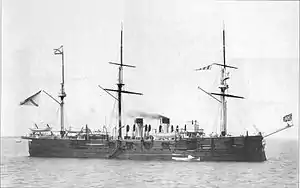Russian cruiser Minin
The Russian cruiser Minin (Russian: Минин) was an armored cruiser built for the Imperial Russian Navy during the 1860s and 1870s. She was renamed Ladoga in 1909 when converted to a minelayer. The ship was sunk in 1915 when she struck a mine laid by a German submarine in the Baltic Sea.
 Minin at anchor after 1887 refit | |
| Class overview | |
|---|---|
| Name: | Minin |
| Operators: |
|
| Preceded by: | General-Admiral class |
| Succeeded by: | Vladimir Monomakh |
| Built: | 1866–78 |
| In commission: | 1878–15 |
| Completed: | 1 |
| Lost: | 1 |
| History | |
| Name: | Minin (Russian: Минин) |
| Namesake: | Kuzma Minin |
| Builder: | Baltic Works, Saint Petersburg |
| Laid down: | 24 November 1866[Note 1] |
| Launched: | 3 November 1869 |
| Completed: | 1878 |
| Renamed: | Ladoga, October 1909 |
| Reclassified: | Minelayer, 1909 |
| Fate: | Sunk, 16 August 1915 |
| General characteristics | |
| Type: | Armored cruiser |
| Displacement: | 6,136 long tons (6,234 t) |
| Length: | 295 ft (89.9 m) |
| Beam: | 49 ft 6 in (15.1 m) |
| Draft: | 25 ft 5 in (7.7 m) |
| Installed power: | 5,290 ihp (3,940 kW) |
| Propulsion: |
|
| Speed: | 14 knots (26 km/h; 16 mph) |
| Range: | 6,000 nautical miles (11,000 km; 6,900 mi) |
| Complement: | 500 officers and crewmen |
| Armament: |
|
| Armor: | |
Design and description
Originally designed as a sister ship to the broadside ironclad Kniaz Pozharsky, the navy was dissatisfied with that ship as it believed that foreign developments had made her obsolete. So the ship was redesigned as a low-freeboard twin-turret ship with full rigging, much like the ill-fated British ship HMS Captain. Already launched when Captain capsized in a storm in 1870, Minin was reconstructed as an armored cruiser with her armament on the broadside and improved machinery.[1]
The ship had an overall length of 309 feet 4 inches (94.3 m), a beam of 49 feet 3 inches (15.0 m) and a draft of 23 feet 7 inches (7.2 m).[2] She displaced 6,136 long tons (6,234 t) at deep load. Her hull was sheathed with copper to reduced biofouling and her crew numbered approximately 545 officers and men.[3]
Minin had a vertical compound steam engine that drove a single propeller, using steam provided by a dozen cylindrical boilers.[3] The engine produced 5,290 indicated horsepower (3,940 kW) which gave her a maximum speed around 12.5 knots (23.2 km/h; 14.4 mph).[2] The ship carried a maximum of 1,000 long tons (1,000 t) of coal[3] which gave her an economical range of 4,200 nautical miles (7,800 km; 4,800 mi) at a speed of 9 knots (17 km/h; 10 mph). She was ship-rigged with three masts.[2] To reduce drag while under sail, the single funnel could be lowered.[1]
The ship had four 8-inch (203 mm), a dozen 6-inch (152 mm) and four 87-millimeter (3.4 in) rifled breech-loading guns. She had a complete waterline belt of wrought iron that ranged in thickness from 7 inches (178 mm) amidships to 6 inches at the ends of the ships.[2] The belt had a total height of 7 feet (2.1 m), of which 5 feet (1.5 m) was below the waterline. Minin had a steel deck 1 inch (25 mm) thick at the top of the belt, but her armament was entirely unprotected.[3]
Construction and career
Minin, named after Kuzma Minin, was laid down by Baltic Works in Saint Petersburg on 24 November 1864 as a turret ship[4] armed with four 11-inch (279 mm) gun in two turrets and four 6-inch guns.[3] The ship was launched on 3 November 1869 and began a complete reconstruction the following year. Minin was finally completed in 1878.[4]
The ship was converted into a minelayer in 1909–11 and renamed Ladoga. Her rigging was reduced to 2 pole masts, her armament was reduced to four 47-millimeter (1.9 in) guns, and she could carry 1000 mines. Ladoga helped to lay the mine barrier in the Gulf of Finland in 1914[1] and was sunk in the Baltic on 15 August 1915 by mines laid by SM UC-4.[3]
Notes
- All dates used in this article are New Style
Footnotes
- Watts, p. 68
- Silverstone, p. 358
- Gardiner, p. 175
- Silverstone, p. 379
References
- Robert Gardiner, ed. (1979). Conway's All the World's Fighting Ships 1860–1905. Greenwich: Conway Maritime Press. ISBN 0-8317-0302-4.
- Silverstone, Paul H. (1984). Directory of the World's Capital Ships. New York: Hippocrene Books. ISBN 0-88254-979-0.
- Watts, Anthony J. (1990). The Imperial Russian Navy. London: Arms and Armour. ISBN 0-85368-912-1.